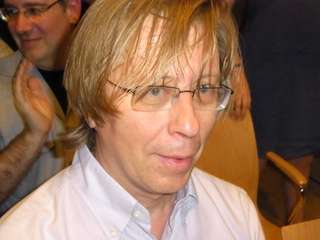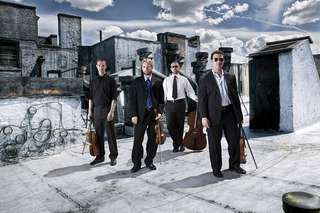|
Back
Darkness on 52nd Street New York
Austrian Cultural Forum, 11 East 52nd Street
09/05/2010 -
Georg Friedrich Haas: String Quartet Number 3 (“In the dark”)
JACK Quartet: Christopher Otto, Art Streisfeld (Violins), John Pickford Richards (Viola), Kevin McFarland (Cello)

G. F. Haas (© Harry Rolnick)
“This piece must be performed in complete darkness. No music-stand lamps and no emergency lighting. The instrumentalists are positioned in the four corners of the room.”
Thus the imperial edict from Austrian composer Georg Friedrich Haas for his Third String Quartet. And thus were the instructions followed to the letter by the JACK Quartet last night, as part of the “Moving Sounds Festival 2010”
How moving they were depended on the listener, but the Austrian Cultural Forum auditorium was filled to capacity. Nobody walked out during the one-hour performance–but truth be told, nobody could walk out Any listener daring to exit through the midnight-black hall would have tripped and fallen. Not a flicker of a shadow could be seen. One literally could not see one’s hand in front of one’s face. (And I have a feeling that some of us actually tried this!)
I was in the humble horrible position of sitting next to the composer, so dared not even jiggle my derrière for fear of reprimand by Mr. Haas. But there was little need for it. Once one got in the spirit of the thing–and once one simply wondered at the marvels of the JACK String Quartet–the work began to show its ebony treasures.
No program notes were given, and the String Quartet did need some explanation. Later I found that the darkness could have been based on the Catholic Church tenebrae section of the Mass. These are the “shadows” or “darkness” nocturnes to be performed three times during Holy Week before Easter.
Or perhaps it was due to Mr. Haas/ proclivity for writing other works (an opera called Night, another Night Shadows) for strobes, darkness, and visual tricks.
But total darkness is different. In fact, we were given a test-minute of total blackness before the music, so nobody would suffer a panic attack. That resembled an advertising trick for a 1950’s 3-D movie, (“Will YOU be able to stand….The DARKNESS??”). But that pure black, while a bit disconcerting, was soon quite comforting.
Nothing, though, deters the JACK Quartet, yet one had to wonder how they had memorized the infinite sounds over duration of the work. They had no score, no light, they were separated by the dimensions of the room, so couldn’t even cue each other.
Add to that Mr. Haas’ disposition for microtonal sounds. Only twice in the composition did one feel that the strings weren’t playing simply notes on the chromatic scale. Instead, each tone wavered a tiny fraction up or down from that note. It added color not ordinarily heard. But at the same time, it should have made things very difficult for these players.

The JACK Quartet (© Justin Bernhaut)
Difficulty, though, does not exist for JACK players. Beginning with a few barely audible squeaks, and some rumblings, their expressions ran the gamut of string playing, from the usual pizzicatos, the thumps on the fingerboard, the tones and resonating overtones together, to the aforesaid microtones, and running, jumping, standing still quartet music, with the most pregnant silences in between.
Those silences, might have signaled the end. But, as Beethoven’s contemporaries used to think he was fooling them with the false endings, we were all waiting for hear which buzzes, gutturals or–hopefully–familiar sounds came through.
We each had our own experiences. I daresay those into meditation might have found the darkness (if not the music) enriching. Others might have looked for structure or repetition. Others could have fallen asleep (unlikely). At times, my mind wandered (I was trying to recall cast members of different John Hustom movies.) Usually it stayed on pitch, though I did, confessedly, wish that the JACK Quartet folks would stand up and say, “Okay, folks, sorry for this. But now we’re going to play some Schubert.”
That never happened. And for my mind, they were only aberrations. Inevitably we were sucked into the scheme of things, though I am uncertain how soon I want to hear it again. But the JACK Quartet had played this several times before, and as one player told me, it is always different.
“We have,” he said later “a series of ‘invitations’ and ‘acceptances.’” The music has a number of invitation signals, and any player can play these, and other may or may not follow. Some repetitions must be made, some themes by Webern must be played, and the ending must be the same each time.
That ending was wild., and my own brain was both titillated and entranced and finally surrendered to these blatantly fortissimo sounds from all four players. One or two would shovel loudly the same note with microtones, others would roam up and down the scale, then they would change players, so it became a gyroscope of musical colors, rhythms and actual pounding furious forces.
After the conclusion, we were like religious pilgrims, having seen the light (literally) trying to decode the revelation.
All of this was baffling, arcane, mysterious unnerving. But at one point, about three-quarters through the piece, they played about eight measures of late Renaissance music, all the modes and archaic lamenting harmonies together.
The composer? This was tenebrae music by that murderous Prince of Verona, Carlo Gesualdo. And it came just in time. For after 45 minutes of pure sounds, I was about to find a knife and plunge it into one of my neighbors.
Not, hopefully, Mr. Haas, who obviously has far more serious optical games and transcendental puzzles for us poor mortals.
Harry Rolnick
|